In conversation with ...
Nicolás Guagnini and Leigh Ledare
Nicolás Guagnini and Leigh Ledare’s joint exhibition XX XX, which took place during November and December 2021 at Meyer Riegger, Berlin, represented the first showing with the gallery of the two New York-based artists and frequent collaborators
The works presented by the artists in the show were created during the pandemic. And while they may seem outwardly very different in nature – Guagnini’s lustrous ceramics and colourful paintings and drawings on one side, and Ledare’s gloomy, uneasy 16mm film on the other – they do, in reality, deal with overlapping themes, most predominantly the social upheaval that the United States of America is continuing to undergo, fuelled by inequality, racism and the rise of neo-fascism.
On the occasion of the show, the artists discussed the impact of the pandemic and the threads that run through their work.
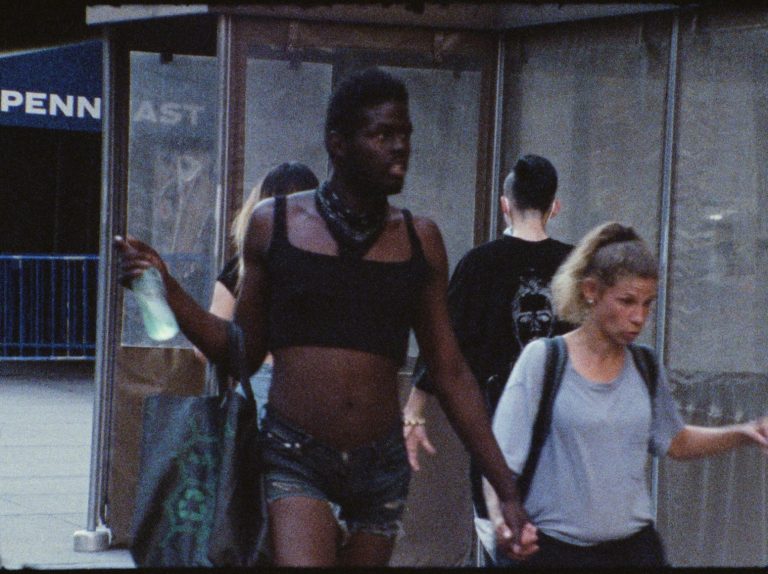
Leigh Ledare, NA JA, 2021, still from 16mm film
December 10, 2021, New York.
Nicolás Guagnini (NG): 2020 presented a unique historical acceleration. The pandemic posed questions to mankind at a bio- anthropological level, and it’s still posing those questions: Are we bound to protect all human beings? Can we dispose of some other human beings? Is the state responsible for every citizen? What is the limit between common good and individual will?
Leigh Ledare (LL): Well, the humanist social contract we’ve taken for granted is threatening to give way to rampant individualism, authoritarianism, or some sort of perverse utilitarianism.
NG: On the one hand it’s Darwinian, and on the other, many people are approaching this from the western rationale of science, or from the perverse capitalistic rationale of an individual consumer: “my choices”. Consumers in front of death!
When the lockdown eliminated social interactions our individual subjectivity got mediated by skill – in my case it’s my manual skill in relation to the body, to the clay, to the paint, to the drawing; and in your case your skill with the camera and with the editorial apparatus of film and moving image, against the backdrop of an extremely antagonistic social situation. So, the question was what to do with that forced autonomy, a “Darwinism of the self” if you will, in relationship to the rise of the alt-right, and the legitimization of violence by that political group. And then the rise in the United States of BLM, and generally the idea of decolonization in real time. There has been a profound human authorization in both directions.
LL: What’s more, a lot of the strategies for resisting the alt-right ended up feeling very idealistic. It was like a form of theater: provocation by the Right, answered by antagonistic rhetoric from the Left, which would be recycled to prop up and fuel the Right. Obviously, the protests were crucial, but at the same time many of these actors became extras in the Right’s propaganda machine. If I remember correctly, you and I were very suspicious of how this moment might be instrumentalized.
NG: Agreed. I think what happens is that our work, which is full of ideas or ideology, cannot entirely answer these energies, and can’t ignore them either. You can bear witness to these energies, and in bearing witness you can position yourself on the side of the human. But I think there is a refusal to find an answer. Or a refusal to tell the spectator what to think. In a way I think that your work, and my work, allow for identification through a wide spectrum, positive and negative identification.
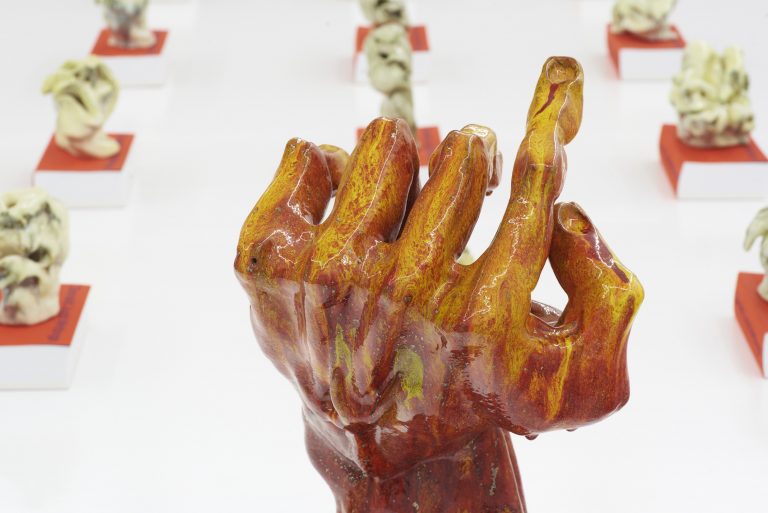
Nicolás Guagnini, The Rally, 2019/2020, ceramic, books, dimensions variable. Photo: Oliver Roura
LL: But wait, let’s slow down for a moment… As much as being a product of the pandemic, for me 2020’s isolation was a reaction to this emerging landscape of alternate realities in America. At the level of the psyche, the political and social fissures engineered under Trump, and spread algorithmically by social media, were deeply divisive. I mean what can you do when nearly half of the country you’ve been raised in develops a cult-like adherence to conspiracy thinking, at their peril and yours, not to mention democracy’s? This spectacle is beyond pornographic, sadistic in the nastiest sense, a cynical game that voids any claim of shared power. Moreover, this fracturing of social marked a fundamental crisis in subjectivity, one that disrupted our relationship to ourselves. It was deauthorizing on all fronts. One option on both sides was to re-authorize the self through adopting a political identity, which offered a semblance of belonging only to re-inscribe and amplify these oppositions. You were either for or against the mythologies being pumped out.
But you’re suggesting that for us, as artists, craft or skill offers another means to relate these external experiences to the self – in this show through your body and a haptic relationship to clay and paint, and in my case through the camera and filming…
NG: Also, very bodily, a floating point of view, your body and the bodies, the discarded bodies of society, the most oppressed bodies of society that are nearly at the point of becoming-trash…
LL: …a model of art as relational object! Returning day after day to film the station, my proximity to this subject matter meant having to relate to that dispossession. In this sense the film reflects both the outside world as well as some internal aspect of myself. That circuit of identification is complex. Nic, while your description is unpleasant, I still think you’re correct to put it so bluntly – for most of society the station inhabitant functions purely as a symbol of abjection, some part of ourselves which, as a larger social body, we find intolerable and obscene. And yet society’s desire to repress this strikes me as exponentially far more obscene. Inside the space of these symptomatic images my identification is ambivalent. These are images of a system which is symptomatic and whose products are symptomatic, and as participants in this same system, we are not exempt… There is no outside. The station serves as an analogy for this social moment as a whole – the viability of the city itself thrown into crisis, its evacuation by those privileged enough to leave, making these stark scenes of the station occupants all the more visible and alarming… the police resentfully refusing to police as a political ploy… all under this specter of contagion – biological, ideological, economic, moral.
In the question of craft there seems to be a double implication: on one hand it offers a permission to engage inside a social context that is full of these antagonisms, and to do so from a basic level of selfhood; and on the other, it provides the survivalist space of tending to its own form and structure, which must mirror that which is being represented.
NG: The craft obliges you, and assists you, to bear witness, because the weight of history is such, what is going on is so accelerated that you need that safe space. Trump is there, the attack on democracy is there. The black people who have been killed are out there in the street, and the white people are out there supporting them. Societies decide to stop, ambulances wailing, and then decide to reopen because the economy is more important than the lives. That’s all out there, and all tinted and permeated by a death drive, and the human interdependence of varied societies is underscored by the sheer biological “universal” intractability of the virus.
In a way this historical acceleration makes us more into instruments, somehow “reducing” or simplifying what it is to be an artist. Supposedly the craft is an instrument of your own ideology – the choice of system of representation being equal to the choice of what is represented. I see bearing witness now as a form of survival. You have to bear witness because there is no other option, this illusion of choice disappears, and you have to resort to your craft because there is no other answer. I think in your case when you have this camera that is almost like a floating point of view between the people who are addicts or homeless, who are either black or recently out of prison, or presumedly headed back… In order to shoot that there has to be a level of identification too… Otherwise you wouldn’t even be able to be there, you would lose your camera, it would get stolen or you would get into trouble, or some kind of shit will happen. You know, you don’t get into these social spaces without a level of belonging, as it were.
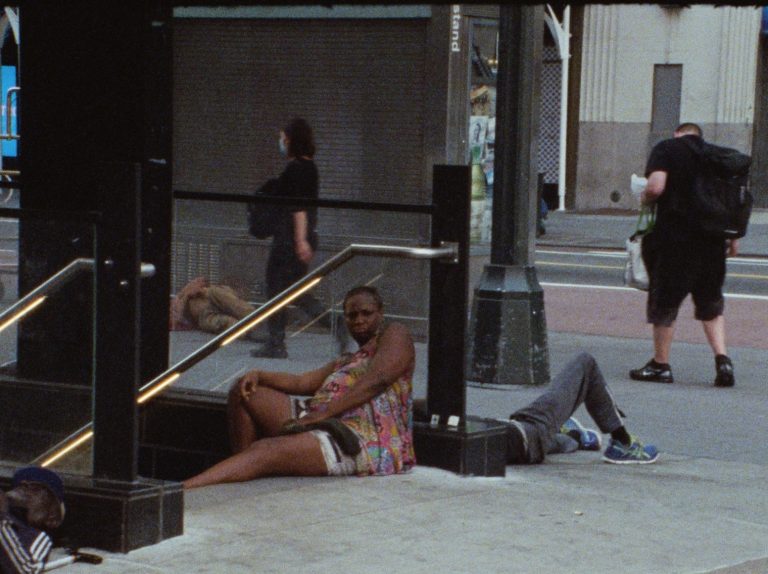
Leigh Ledare, NA JA, 2021, still from 16mm film
LL: Identification, absolutely… but based on an act of resisting disidentification, of turning towards this reality we’re not supposed to see, a kind of abyss we’re not allowed to stare into. And there’s a vertigo in this. For me, filming the station represented an attempt to assuage the alienation caused by months of receiving information about the pandemic only online, while ironically life felt so offline. In that landscape, everyone including the station inhabitants was painfully aware that whatever they’d formerly relied on as a future, it was now foreclosed. So a crisis in meaning, a crisis in sanity. New terms of survival, a need for new tools. This posed the question of how to adapt not only at an existential level but also an artistic one?
In a subtle way the sound that accompanies these images underscores this. It’s a simple premise: a reinterpretation that Paul McCarthy and I made of 1968 Beuys’ sound piece, ‘Ja ja ja, ne ne ne’, revisited vis-à-vis the social/visual field of the film. Recorded apart from the station, then montaged over these images, this pure dialectic of yes/no, affirmation/negation drifts between addresses. At times it suggests an internal dialog for the subjects we see perambulating through the station; at other times it omnipotently floats above the scene, evoking judgement or assessment, pointing a finger towards life or death; and at others the polyphonic vocalization conjures an intersubjective space between the figures inside image – but always pointing back to implicate the viewer and me alike. “Yes”; “No”; “Yes and no”; “Neither yes nor no” – a full spectrum of discursive positions building upon and cancelling one another. In other words, like the complete ungovernability of these images, this sound component reinforces the fact that, as of yet, no solutions are possible, suspended inside this moment all significance in choice is obliterated. This was an attempt to look this moment in the eyes… to propose an internal mirror: the moment facing itself, negating and affirming itself, and affirming its negation… to look into this blind spot, inside the city and seemingly outside of morality. And yet, at its core it’s a refusal to turn away… back to the role of witness.
NG: And that itself is the craft, no? What builds the system is the antagonism. What drives the system is a succession of antagonisms, that’s what fuels the system.
LL: The agon which I capture in the film, and you capture in the tableaux…
NG: You know to make the faces, the deformed faces admiring the authoritarian leader I spend a good deal of time in front of the mirror deforming my own face… I just close my eyes, and with the distortions that are particularly interesting I just touch my face with a distorted expression. And that creates some kind of bodily memory in my hand and I repeat that in the clay. What I’m trying to say is that to make that work you have to be that thing that you’re witnessing. There’s no witnessing without being that thing that is being witnessed.
LL: There is definitely truth in that. But to take your tableau, there are multiple positions inside the system, at least three: the hand of the authoritarian leader, which at first glance might be Trump, but with a turn of the kaleidoscope is reconfigured as something or someone else… perhaps even you!
NG: Yes, Trump, or the little privilege inside each of us. It can be the buyer, it can be the dealer, it can be me.
LL: And always, the disfigured followers, which remind me of Daumier, a pantheon of caricatures. And then standing at a remove, the spectators, bad-footed with holes in their heads, more or less passively watching.
NG: Those figures are more like anti-vaxxers.
LL: Ha! Or even more relatable… an analogy for the Left.
NG: Yes, the Left perpetually suspended between utopia and nostalgia. Watching an ideal past and an ideal future while each and every position gets lost.
LL: It makes me think of your upbringing in Argentina at a time plagued by political violence. For me, your history suggests an elimination of any role as follower. Your identification split. As a subject you’re an insider, but one who can also be outside himself, all by virtue of this relationship to collective trauma. This circles back to a question concerning the artist’s role in society, and in particular the artist’s role as a container, holding this whole mess. Perhaps modeling it also suggests a form of controlling it, an authoritarianism at the level of one.
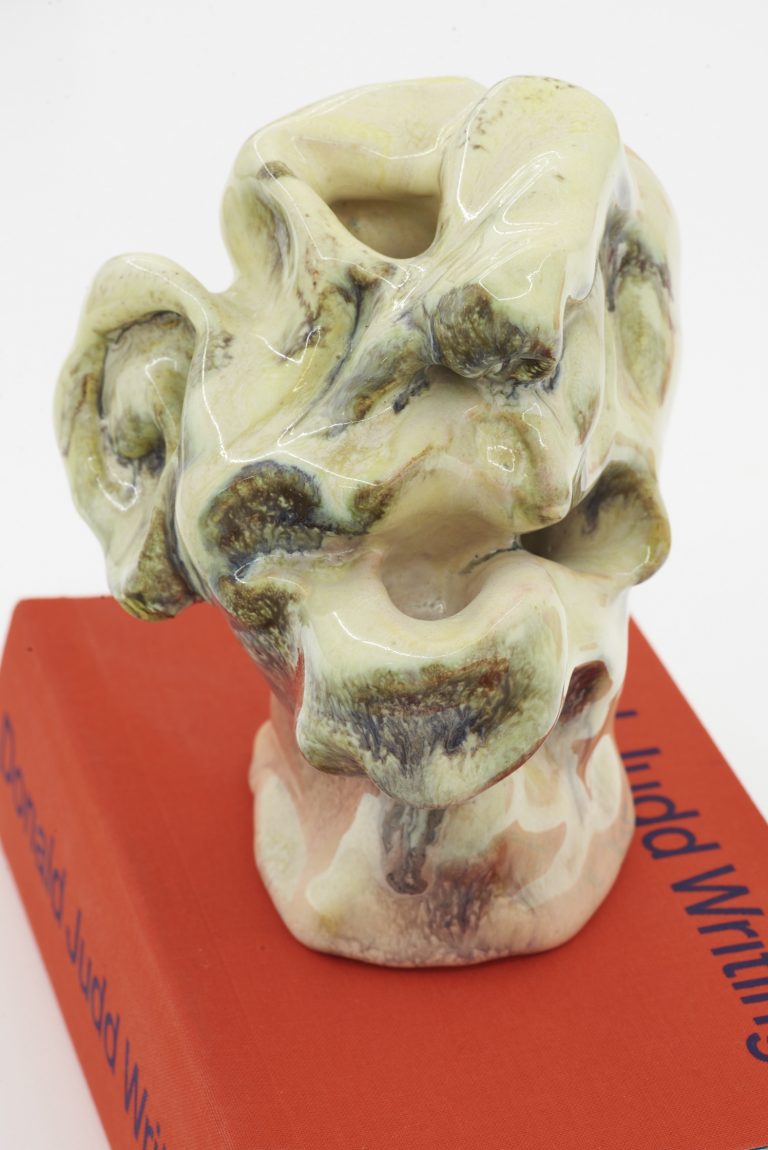
Nicolás Guagnini, The Rally, 2019/2020, ceramic, books, dimensions variable. Photo: Oliver Roura
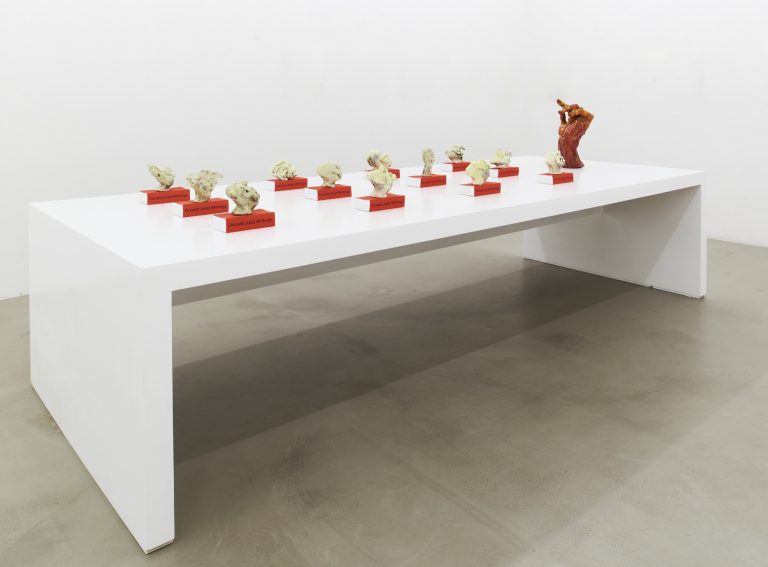
Nicolás Guagnini, The Rally, 2019/2020, ceramic, books, dimensions variable. Photo: Oliver Roura
NG: Surely, but it’s one thing being fascist with yourself, and another thing is to decolonize your own self. The bare subjectivity of the artist in a time like this has to do with not evading any responsibility towards what’s going on, but also not proposing an answer or a solution. Pointing to the problem is not enough. Offering an answer to the problem is doomed to insufficiency. And I think that is the real antagonism in our work – that it seduces you in, shows you the problem, and that it doesn’t give you an answer or a solution.
LL: But it places you amidst all the contradictions, implicating you in all angles of the conflict.
NG: In that level and type of antagonism, I see the long shadow of Mike Kelley.
LL: …whose world also hinges on withholding moral positions. Obviously, there’s also that survivor’s humor.
NG: In terms of my traumatized childhood growing up in a dictatorship, and your own traumatized childhood, essentially in a broken family at the fringe of failed whiteness – and, if I’m not mistaken your father went into QAnon conspiracy theories, so you’re a witness to that too – I think that what distinguishes us from other people who are victims of something is that, again, we don’t predicate our victimhood as a denunciation of something to which we can propose a solution. Which I don’t think we can. The one thing we can do is, as you say, show models. Models of apprehension, social models, models of behavior, or of systems and how systems are constructed. Or show the implication between aesthetics and systems. This may sound infinitely wordy or fatuous, but it’s actually demanding to sustain as a position and ultimately precise.
LL: Absolutely, and it’s situational. It necessitates a kind of radical self-implication, even hinges on it. Whether this means the artist literally appearing inside the system, as we’ve both done in works that are more directly related to performance, or allowing this strategy of opacity to provoke the viewer to grapple with the contradictions in their own position, thereby activating them to sound out cracks and contradictions that aren’t immediately apparent. Inside the psychosocial system in which I grew up, survival was always a question of negotiating these conflicting interests.
NG: The difficulty, I think, in our position has to do with the seduction of the spectator, because it forces the spectator to become identified with all the positions that are unacceptable, to look at the beauty in those situations which we cannot tolerate, and yet those are the situations in which we live.
LL: And I think this point is crucial, because amidst all this turmoil it’s true, there is also a great deal of beauty. Even if it only emerges through the mapping of something fraught, and systems are always fraught, it’s there in this reflection of complexity.
NG: But mapping implies that there is an overall system that you will comprehend, that there are meridians, that there are data points, that there is an app or a logic. And there’s something very voyeuristic about showing what you show in the film, or what I show on that table. And that’s where the implication comes in, in the voyeurism. Like look, you don’t want to look at it, but you do….you do….I know you do and you know I know…
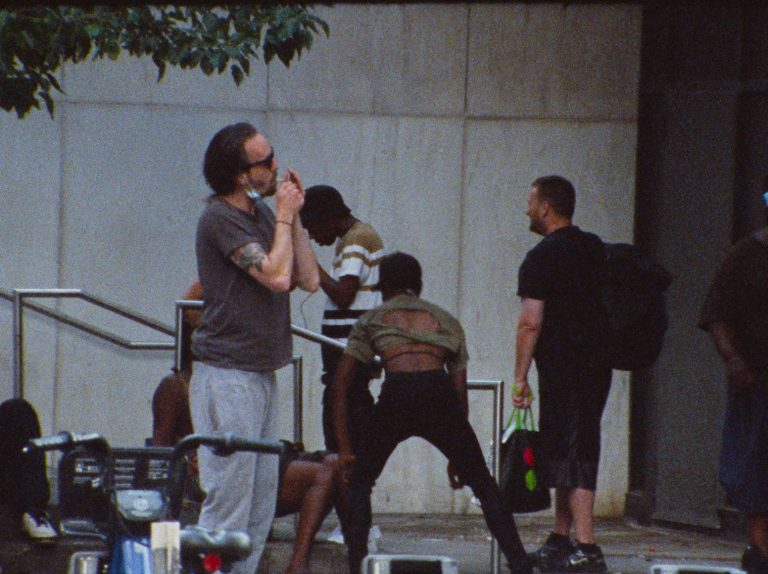
Leigh Ledare, NA JA, 2021, still from 16mm film
